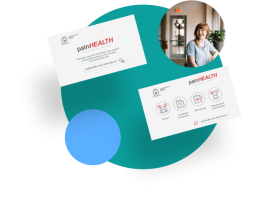Fibromyalgia
Learn about the current understanding of fibromyalgia and how you can manage it in partnership with your healthcare team.
Last updated: 28 Oct 2023 · 7 min read
Fibromyalgia (FM) is the name given to a cluster of symptoms of varying severity that are commonly present in 2-8% of members of the community. Women are twice as likely to complain of these symptoms as men.
The many symptoms do not indicate any specific recognised disease process. There is now good evidence to suggest that the same symptoms found in people with FM are similar to those present in animals who are sick and/or responding to severe stress.
Recent studies in animals and humans suggest that whenever stress responses are activated, a neuro-immune process is accentuated within our central nervous system. This is called “neuroinflammation”.
Neuroinflammation means that chemical substances released by immune cells in the nervous system, make the nerve cells more sensitive to stimulation. This means that everyday stimulation like light touch, cold or heat, and even movement, while not damaging, can evoke a painful response. We call this painful response “allodynia” (meaning “other pain”).
What are the symptoms of Fibromyalgia?
A variety of symptoms form the fibromyalgia cluster. These include:
- Widespread pain
- Disturbed sleep
- Fatigue
- Disturbed thinking and capacity for making decisions
- Sensitivity to hot and cold temperatures
- Sensitivity to loud noises or bright lights
- Impaired memory
- Low mood (depression) or anxiety.
You may also experience associated conditions such as irritable bowel syndrome, painful menstrual periods, chronic fatigue and other visceral (gut and bowel) conditions. It is important to consult your doctor to check your symptoms, as there can be other medical reasons to explain some of these symptoms.
How do you diagnose Fibromyalgia?
- Your GP can make the diagnosis.
- You may be referred to a specialist, often a rheumatologist.
- At present, there is no laboratory test that can diagnose FM or rule it out.
- Repeated blood testing is strongly discouraged.
Fibromyalgia diagnostic criteria were updated in 20163. FM may now be diagnosed in adults when all of the following criteria are met:
- Generalised pain, defined as pain in at least 4 of 5 body regions, is present.
- Symptoms have been present at a similar level for at least 3 months.
- Widespread pain index (WPI) ≥ 7 and symptom severity scale (SSS) score ≥ 5 OR WPI of 4–6 and SSS score ≥ 9.
- A diagnosis of fibromyalgia is valid irrespective of other medical diagnoses. Therefore, a diagnosis of fibromyalgia does not exclude the presence of other clinically important illnesses. This means that your doctor does need to consider the possibility that other clinically important illnesses may be present and cannot rely solely upon interpreting your responses to these questionnaires (WPI and SSS).
What treatments are available for Fibromyalgia?
Specific treatment for the condition is not currently available. This is because the underlying problem in patients with fibromyalgia properly lies with systems of bodily defense, that cannot be switched off.
Most recommended treatments currently being offered is to do with lifestyle habits. See our Fibromyalgia value-based care fact sheet.
Such treatment includes exercise, activity pacing, cognitive (mind-body therapies), improving sleep hygiene, and consuming a balanced diet.
Current evidence recommends that treatments should include both non-pharmacologic (e.g. exercise, activity, diet, sleep hygiene) and pharmacologic (medicines) strategies. It is very important that you are actively involved in managing your FM, in partnership with your healthcare team (this is known as self-management)2,4.
Treatment for a whole-body system disturbance can be put under the WHOPE banner – whole person engagement. Treatments may include:
- Improving your sleep routine
- Relaxation
- Meditation strategies
- Pacing your activity
- Exercise
- Goal setting
- Controlling your mood and your physical/emotional “load” or stress
- Medicines
Try focusing on 1 or 2 small achievable goals. For example, improving your sleep routine is a great start to better managing your pain. Developing a regular sleep time and routine will help to reduce your pain and may improve your mood.
Using a low dose anti-depressant may help you to regulate your sleep: discuss this with your doctor. Improved sleep means less pain and allows you to undertake more carefully paced activity and exercise. So, rather than using a single approach (like medications), you have coupled up a few simple strategies (sleep, medications and paced activity). This approach can make a big difference to your pain over time.
To date there has been no one dietary change that helps everybody with FM5; what helps one person may not be useful to another. Most importantly, if you intend to change your diet make sure that you are able to maintain adequate nutrition. If you need advice, discuss this with your doctor or a dietician.
Download our postcard
We've just created a postcard PDF you can download to share with your patients easily.
What is the role of medications in managing Fibromyalgia?
Like many other painful conditions, medications can play a role in the management of FM, but are not recommended as a standalone treatment2. The aim of using medications is to help keep you mobile and stay involved in the things you love to do. Side effects from medications can vary and you should ask your doctor about the risks and benefits of your prescribed medicines.
The medications recommended for use in FM are designed to calm down the nervous system, reducing hypersensitivity. Evidence to support these medications in treating FM is lacking on the whole5, so it is important to discuss with your doctor what options they recommend.
Prescribed medications include:
- Simple analgesics: paracetamol and non-steroidal anti-inflammatory drugs (NSAIDs)
- Opioids: drugs in this family (e.g. morphine, oxycodone, tapentadol, tramadol) need to be prescribed with caution and have risks, side effects and potential harm
- Anti-depressants (in low dose): Amitryptiline, Nortryptiline and Trimipramine
- Serotonin-noradrenaline reuptake inhibitors: Duloxetine, Venlafaxine
- Anti-convulsants: gabapentin, pregabalin
Comment: All too often the benefit obtained from any of the above prescribed medications is outweighed by their risks and side effects.
Less commonly prescribed medications that are still being evaluated: sodium oxybate, quetiapine, esreboxetine, nabilone, memantine, melatonin, and low-dose naltrexone. There is not yet sufficient evidence to recommend melatonin7.
There is a huge amount of research currently being done to try to find new medications which might be usefully prescribed to people with FM.
Ask your doctor about any medicines or natural agents to ensure you get accurate information about risks, benefits and evidence for its use. Some medications have been shown to have little benefit and can cause many side effects, such as the morphine (opioid) family.
You can read more in our medicines and procedures module, which outlines the different medicines, their pros and cons and how they might fit into your overall management.
Complementary and alternative medicine
The best available evidence indicates consistently positive results for tai chi, yoga, meditation and mindfulness-based interventions, hypnosis or guided imagery, electromyogram (EMG) biofeedback, balneotherapy (mineral spa therapy) and hydrotherapy.
Inconsistent evidence is reported for qigong, acupuncture, chiropractic interventions, electroencephalogram (EEG) biofeedback, and nutritional supplements.
Inconclusive results were found for homeopathy and phytotherapy (plant extracts).
Helpful tips to manage Fibromyalgia
- Set yourself little tasks you can achieve TODAY
- Pace your activities: this means doing small bits often or taking the middle road, rather than overdoing or under doing. This also helps to conserve energy. See the pacing and goal setting module.
- Exercise a little everyday7. Doing exercise you like, means that you are more likely to do it, even if this is only a short walk
- Exercise is good for your general well-being, your mood, heart and lungs, joints and muscles, your balance and your bone health. Check out the movement with pain module
- Gentle stretching and relaxation are often useful options. Try changing positions frequently rather than staying in one position for extended periods
- A regular sleep routine is very important - a dark room, same time, and quiet music may help. Check out our sleep and pain module
- Planning your work and social activities ahead helps you think about ways you can better manage challenging situations or pain flares. Possibly only going for part of the function rather than all will help manage your energy levels and pain levels. You may find the work and pain module helpful
- Asking your family or friends to help where possible, may not only help you, but also help them to understand your condition
Want further information?
For more information about Fibromyalgia, visit Arthritis Australia, Musculoskeletal Australia or the Fibromyalgia Support Network of WA and Cochrane Plain Language Summaries. Alternatively, if you want to talk to someone about Fibromyalgia, please seek further assistance.
Making sense of pain
Pacing and goal settings
Movement with pain
Approaching Pain
Fibromyalgia: Promoting wise healthcare
Chronic and Non-Cancer pain management plan
Fibromyalgia | Arthritis Australia
Exercise and Fibromyalgia | Arthritis Australia
- Walitt B, Nahin RL, Katz RS, et al. The prevalence and characteristics of fibromyalgia in the 2012 National Health Interview Survey. PLOS ONE 10(9): e0138024. [PubMed]
- Lyon P, Cohen M, Quintner J. An evolutionary stress-response hypothesis for chronic widespread pain (fibromyalgia syndrome). Pain Med 2011; 12: 1167-1178. [PubMed]
- Woolfe CJ. Central sensitization: implications for the diagnosis and treatment of pain. Pain 2011; 152: S2-S15. [PubMed]
- Sandkühler, J. (2017, October 26). Neuroinflammation and Neuroplasticity in Pain. Oxford Research Encyclopedia of Neuroscience. Retrieved 26 Nov. 2019, from https://oxfordre.com/neuroscience/view/10.1093/acrefore/9780190264086.001.0001/acrefore-9780190264086-e-56 [PDF]
- Wolfe F, Clauw DJ, Fitzcharles M-A. et al. 2016 revisions to the 2010/2011 fibromyalgia diagnostic criteria. Semin Arth Rheum 2016; 46: 319-329. [PubMed]
- Lauche R, Cramer H, Hauser W, et al. A systematic overview of reviews for complementary and alternative therapies in the treatment of fibromyalgia syndrome. Evid Based Complement Alternat Med 2015. Article ID 610615. http://dx.doi.org/10.1155/2015/610615 [Hidawi]
- Blumenthal DE, Malamud CJ. Recent strategies for drug development in fibromyalgia syndrome. Expert Rev Neurother 2016;16(12):1407-1411. PMID: 27362466; [PubMed]
This module has been developed by John Quintner, FFPMANZCA, Retired Rheumatologist and Physician in Pain Medicine. Project Officer (volunteer), Arthritis and Osteoporosis, Perth, Australia.
The information in this module is based on current best evidence research and clinical practice.
SHARE THIS ARTICLE
Pain management information, stories and tips accessible anywhere, anytime.
Access clinically supported practical musculoskeletal pain management information to help you understand pain, how you can manage your pain with your management team on the go on any device.

